2012 PEUGEOT 107 seats
[x] Cancel search: seatsPage 48 of 140

46Visibility
Headlamp
adjustment
In this position, it comes on on
opening the driver's door.
The cour tesy lamp is deactivated andis permanently off.
Courtesy lamp
Permanently on. To avoid causin
g a nuisance to other road
users, the height of the headlamps should be adjusted in relation to the load in the vehicle.0. 1 or 2 people in the front seats. -. 3 people.1. 4 people.
2.
4 people + maximum authorised load. 3.
Driver + maximum authorised load.
The initial setting is position "0"
.
Page 53 of 140
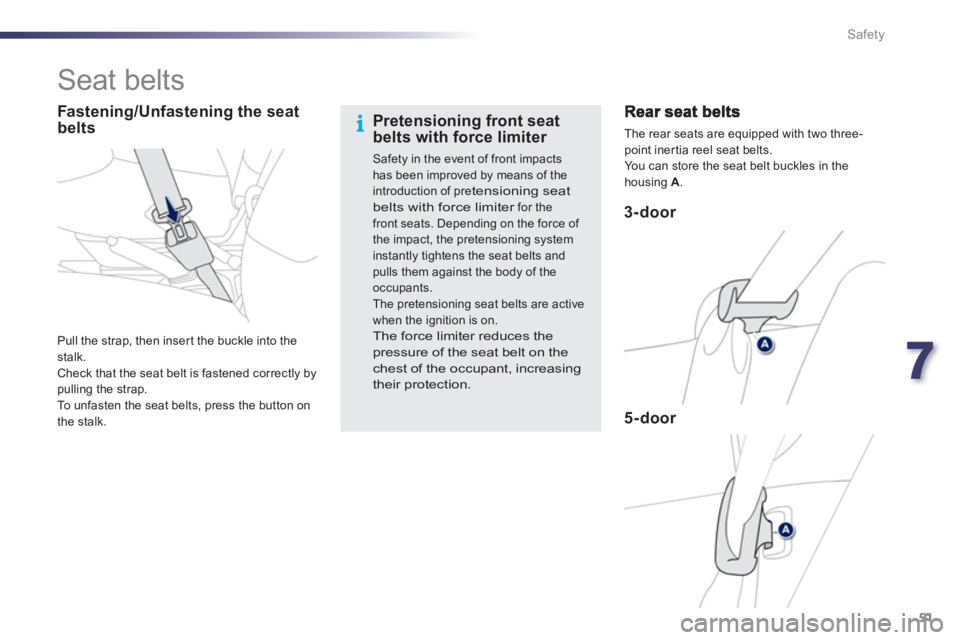
7
51 Safety
Seat belts
3-door
5-door
The rear seats are equipped with two three-point inertia reel seat belts.
Yo u can store the seat belt buckles in the housing A.
Pull the strap, then inser t the buckle into thestalk.
Check that the seat belt is fastened correctly bypulling the strap.
To unfasten the seat belts, press the button on
th
e stalk.
Pretensioning front seat belts with force limiter
Safety in the event of front impactshas been improved by means of theintroduction of pretensioning seatbelts with force limiterfor therfront seats. Depending on the force of the impact, the pretensioning systeminstantly tightens the seat belts and pulls them against the body of the occupants.
The pretensioning seat belts are activewhen the ignition is on.
The force limiter reduces the pressure of the seat belt on the chest of the occupant, increasingtheir protection.
Fastening/Unfastening the seatbelts
Page 55 of 140
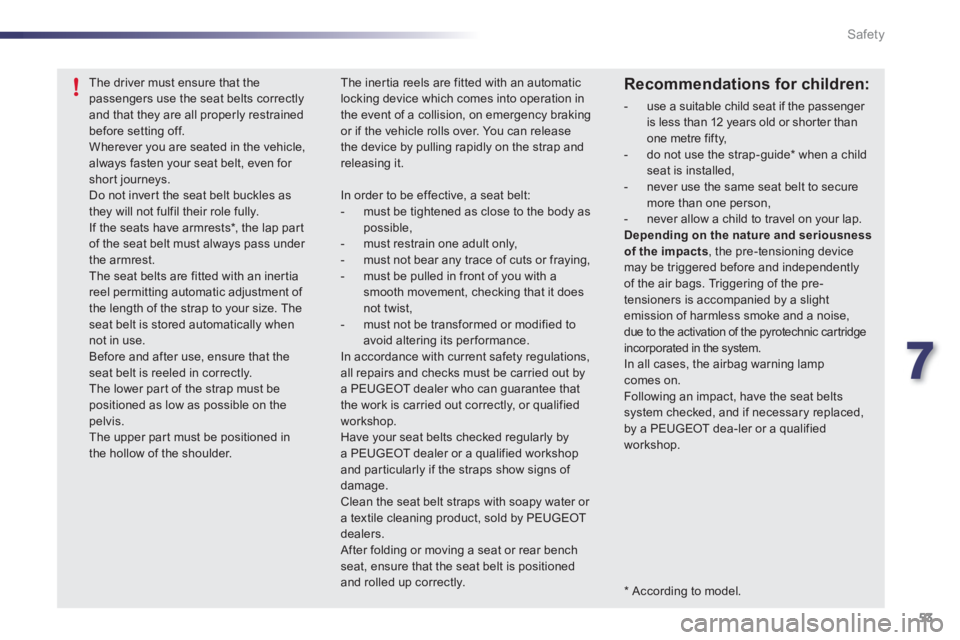
7
53 Safety
* According to model.
The driver must ensure that thepassengers use the seat belts correctly and that they are all properly restrainedbefore setting off. Wherever you are seated in the vehicle,always fasten your seat belt, even for shor t journeys. Do not invert the seat belt buckles as they will not fulfil their role fully. If the seats have armrests * , the lap par tof the seat belt must always pass under the armrest.The seat belts are fitted with an inertiareel permitting automatic adjustment of the length of the strap to your size. The seat belt is stored automatically whennot in use. Before and after use, ensure that theseat belt is reeled in correctly.The lower part of the strap must be positioned as low as possible on the pelvis. The upper par t must be positioned in the hollow of the shoulder.
The inertia reels are fitted with an automaticlocking device which comes into operation in the event of a collision, on emergency braking or if the vehicle rolls over. You can release the device by pulling rapidly on the strap and releasing it.
In order to be effective, a seat belt: - must be tightened as close to the body aspossible, - must restrain one adult only, - must not bear any trace of cuts or fraying,- must be pulled in front of you with asmooth movement, checking that it doesnot twist, - must not be transformed or modified to avoid altering its performance.In accordance with current safety regulations, all repairs and checks must be carried out bya PEUGEOT dealer who can guarantee thatthe work is carried out correctly, or qualifiedworkshop. Have your seat belts checked regularly by a PEUGEOT dealer or a qualified workshopand par ticularly if the straps show signs of damage.Clean the seat belt straps with soapy water or a textile cleaning product, sold by PEUGEOT dealers.
After folding or moving a seat or rear bench seat, ensure that the seat belt is positioned and rolled up correctly.
Recommendations for children:
- use a suitable child seat if the passenger is less than 12 years old or shor ter thanone metre fifty,
- do not use the strap-guide *
when a child seat is installed,
- never use the same seat belt to securemore than one person,
- never allow a child to travel on your lap.Depending on the nature and seriousness of the impacts
, the pre-tensioning device may be triggered before and independently of the air bags. Triggering of the pre-tensioners is accompanied by a slight emission of harmless smoke and a noise, due to the activation of the pyrotechnic cartridge incorporated in the system.
In all cases, the airbag warning lamp comes on. Following an impact, have the seat beltssystem checked, and if necessary replaced, by a PEUGEOT dea-ler or a qualified workshop.
Page 58 of 140

56Safety
Front airbags
Do not drive holding the steering wheel by its
spokes or resting your hands on the centre part
of the wheel.
Passengers must not place their feet on the
dashboard.
Smoke as little as possible; deployment of the
airbags can cause burns or the risk of injuryfrom a cigarette or pipe.
Never remove or pierce the steering wheel or hit it violently.
Curtain airbags
Do not fix or attach anything to the pillars or the
roof. This could cause injury to the head when
the cur tain airbag inflates.
The deployment of an airbag or airbags is
accompanied b
y a slight emission of harmlesssmoke and a noise due to the activation of
the pyrotechnic cartridge incorporated in the system. This smoke is not harmful but sensitiveindividuals may experience some irritation.
The detonation noise may result in a slight loss
of hearing for a shor t time.
Even if all of the precautions mentioned are
observed, injury or slight burns to the head,chest or arms when the air bag is deployed cannot be ruled out. Indeed, the bag inflates
almost instantly (approximately 30 milliseconds)
then deflates within the same time discharginghot gas via the openings provided for thispurpose.
This equipment will only operate once. If a second impact occurs (during the same or asubsequent accident), the airbag will not inflate.
Lateral airbags
Only put approved covers on the seats, these
will not hamper the inflation of the lateral
airbags. Contact a PEUGEOT dealer or a qualified workshop.
Do not fix or attach anything to the front seatbacks. This could cause injury to the chest or
arms when the lateral airba
g inflates.
Do not sit with the upper par t of the body any
nearer to the door than necessary.
For the front, lateral and cur tain airbags to be fully effective, obser ve the following safety rules:Wear a correctly adjusted seat belt. Sit in a normal upright position. Do not leave anything between the occupants and the airbags (child, animal, object...). This could hamper the operation of the airbags or injure the occupants. All work on the airbag systems is strictly prohibited unless it is carried out by qualified personnel of the PEUGEOTdealer network or a qualified workshop.
After an accident or if the vehicle has been stolen or broken into, have theairbag systems checked.
Page 59 of 140
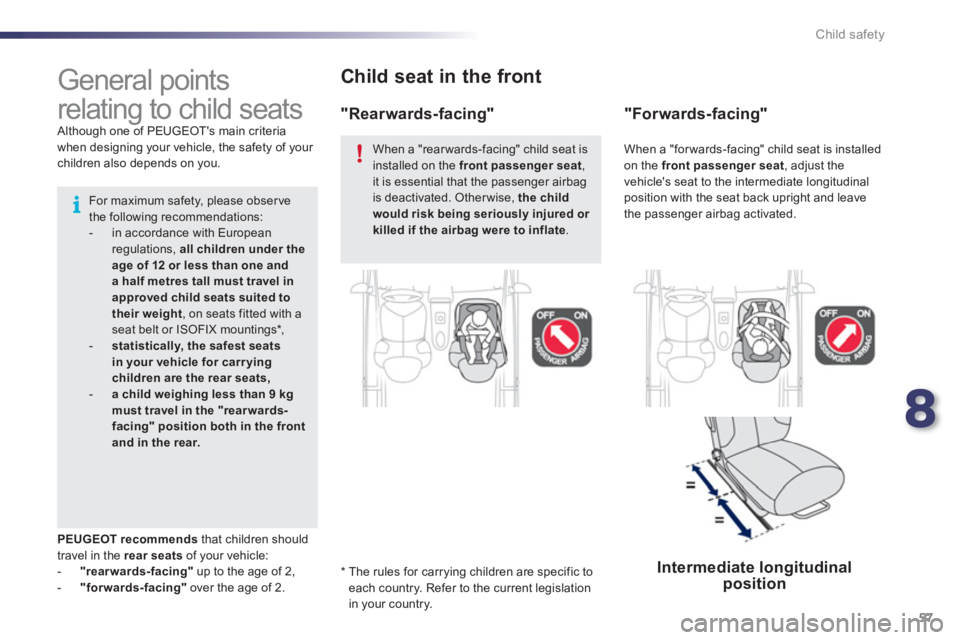
8
57 Child safety
Child seat in the front
*
The rules for carrying children are specific toeach country. Refer to the current legislation
in your country.
General points
relating to child seats
Although one of PEUGEOT's main criteria
when designing your vehicle, the safety of your children also depends on you.
"Rearwards-facing"
PEUGEOT recommends that children should
travel in the rear seats
of your vehicle:
- "rearwards-facing"up to the age of 2,
-
"forwards-facing"
over the age of 2.
"Forwards-facing"
Intermediate longitudinalposition
For maximum safety, please observethe following recommendations: - in accordance with European regulations, all children under theage of 12 or less than one and a half metres tall must travel in approved child seats suited totheir weight
, on seats fitted with a seat belt or ISOFIX mountings *
, -statistically, the safest seats in your vehicle for carr yingchildren are the rear seats,- a child weighing less than 9 kgmust travel in the "rear wards-facing" position both in the frontand in the rear.
When a "rear wards-facing" child seat isinstalled on the front passenger seat
, it is essential that the passenger airbagis deactivated. Other wise, the child would risk being seriously injured or killed if the airbag were to inflate.
When a "forwards-facing" child seat is installed on the front passenger seat
, adjust the
vehicle's seat to the intermediate longitudinal
position with the seat back upri
ght and leave
the passenger airbag activated.
Page 61 of 140
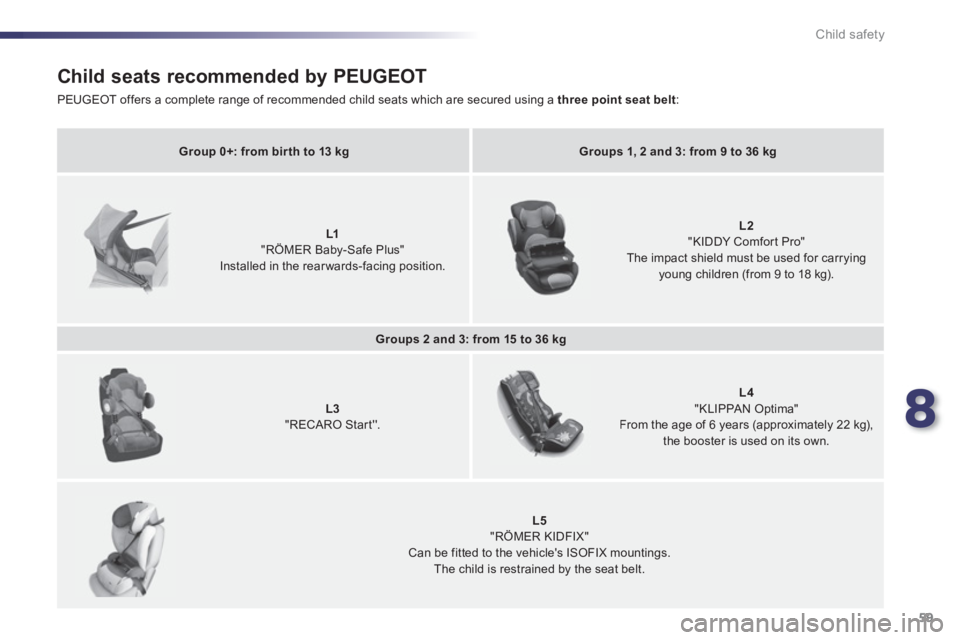
8
59 Child safety
Child seats recommended by PEUGEOT
PEUGEOT offers a complete range of recommended child seats which are secured using a three point seat belt:
Group 0+: from bir th to 13 kgGroups 1, 2 and 3: from 9 to 36 kg
L1"RÖMER Baby-Safe Plus" Installed in the rear wards-facing position.
L2
"KIDDY Comfort Pro" The impact shield must be used for carryingyoung children (from 9 to 18 kg).
Groups 2 and 3: from 15 to 36 kg
L3"RECARO Start''.
L4"KLIPPAN Optima"From the age of 6 years (approximately 22 kg),
the booster is used on its own.
L5
"RÖMER KIDFIX"Can be fitted to the vehicle's ISOFIX mountings.The child is restrained by the seat belt.
Page 62 of 140
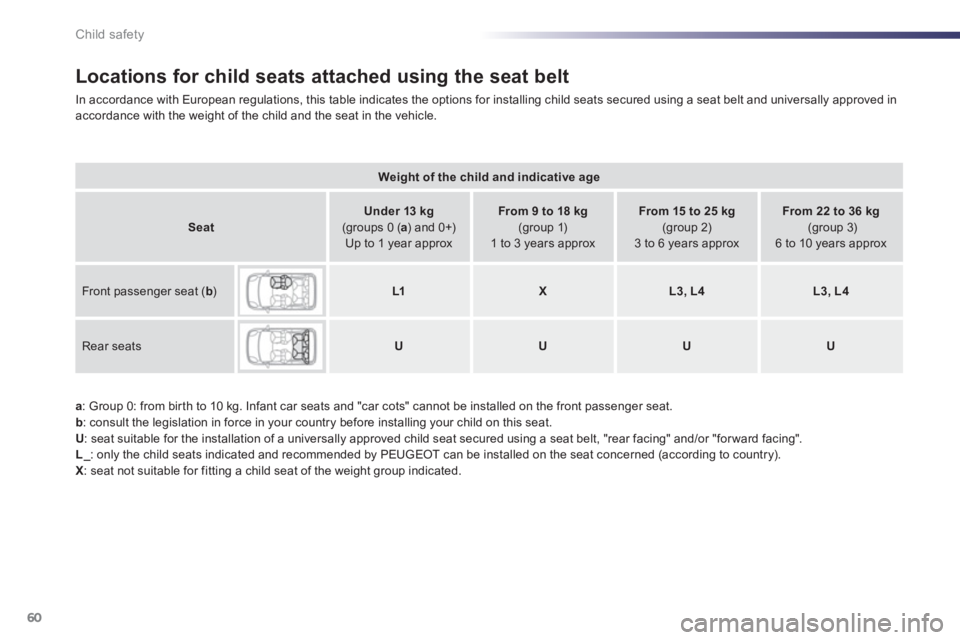
60Child safety
Locations for child seats attached using the seat belt
In accordance with European regulations, this table indicates the options for installing child seats secured using a seat belt and universally approved inaccordance with the weight of the child and the seat in the vehicle.
a : Group 0: from bir th to 10 kg. Infant car seats and "car cots" cannot be installed on the front passenger seat. b: consult the legislation in force in your country before installing your child on this seat.
U
: seat suitable for the installation of a universally approved child seat secured using a seat belt, "rear facing" and/or "forward facing". L_
: only the child seats indicated and recommended by PEUGEOT can be installed on the seat concerned (according to country)._X
: seat not suitable for fitting a child seat of the weight group indicated.
Weight of the child and indicative age
Seat
Under 13 kg
(groups 0 (a ) and 0+)
Up to 1 year approx
From 9 to 18 kg
(group 1)
1 to 3 years approx
From 15 to 25 kg
(group 2)
3 to 6 years approx
From 22 to 36 kg
(group 3)6 to 10 years approx
Front passenger seat (b ) L1XL3, L4L3, L4
Rear seatsUUUU
Page 63 of 140
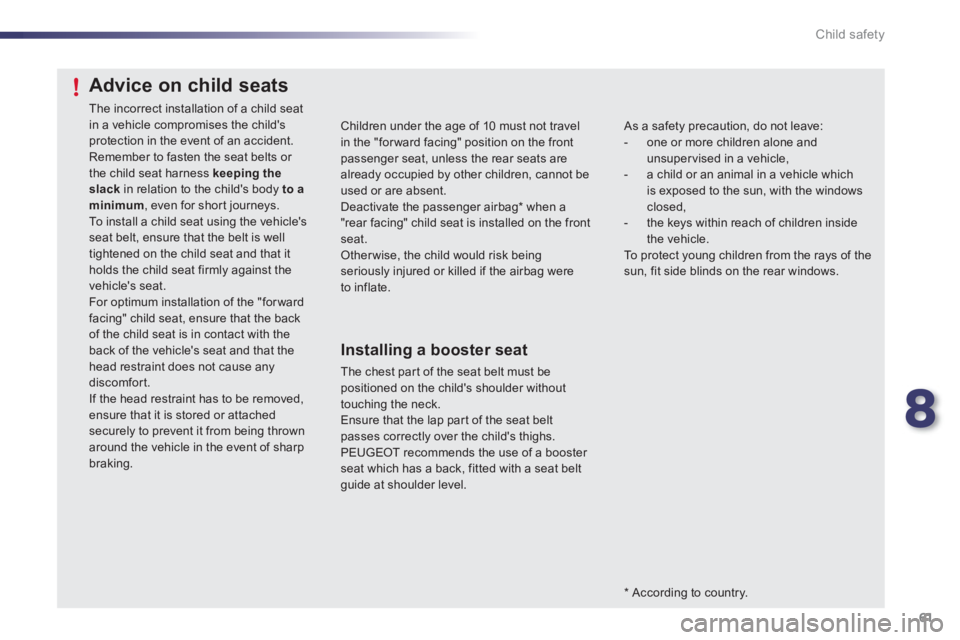
8
61 Child safety
Children under the age of 10 must not travelin the "forward facing" position on the front passenger seat, unless the rear seats are already occupied by other children, cannot be used or are absent.Deactivate the passenger airbag * when a "rear facing" child seat is installed on the front seat. Other wise, the child would risk beingseriously injured or killed if the airbag were to inflate.
As a safety precaution, do not leave:
- one or more children alone and unsupervised in a vehicle,
- a child or an animal in a vehicle which is exposed to the sun, with the windowsclosed,
- the keys within reach of children insidethe vehicle.
To protect young children from the rays of the sun, fit side blinds on the rear windows.
Installing a booster seat
The chest par t of the seat belt must bepositioned on the child's shoulder without touching the neck.Ensure that the lap part of the seat belt
passes correctly over the child's thighs.PEUGEOT recommends the use of a booster seat which has a back, fitted with a seat beltguide at shoulder level.
*
According to country.
Advice on child seats
The incorrect installation of a child seat in a vehicle compromises the child's protection in the event of an accident.Remember to fasten the seat belts or the child seat harness keeping theslackin relation to the child's body to aminimum, even for short journeys.To install a child seat using the vehicle's seat belt, ensure that the belt is welltightened on the child seat and that itholds the child seat firmly against the vehicle's seat. For optimum installation of the "forward facing" child seat, ensure that the back of the child seat is in contact with the back of the vehicle's seat and that thehead restraint does not cause any discomfort. If the head restraint has to be removed,ensure that it is stored or attached
securely to prevent it from being thrownaround the vehicle in the event of sharpbraking.